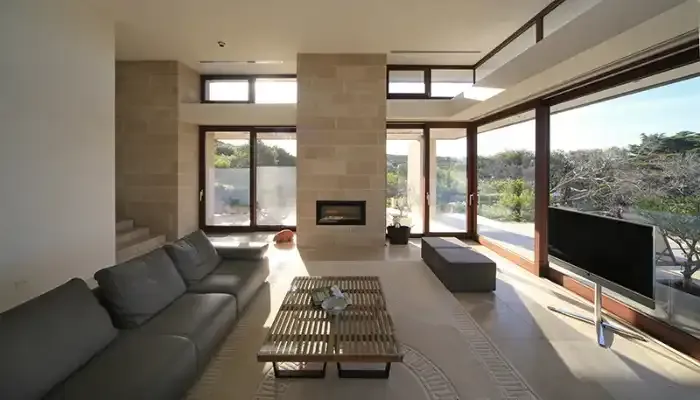Natural light is more than just a way to illuminate your home – it’s a vital element for creating a healthy and inviting living environment. Studies have shown that exposure to natural light can boost mood and energy levels by regulating the body’s circadian rhythm, the internal clock that controls our sleep-wake cycle.
It can also enhance cognitive function and improve productivity, making it easier to focus and be productive throughout the day. Additionally, natural light has been shown to reduce symptoms of seasonal affective disorder (SAD), a mood disorder that can occur during the winter months when there is less sunlight.
Finally, natural light can create a more spacious and airy feel within your home, making it a more pleasant and inviting place to be.

Harnessing the Power of Natural Light
Before diving into strategies to maximize natural light, it’s important to assess your home’s potential. Here’s a roadmap to get you started:
Understanding Your Home’s Light Potential
- Identify Key Areas: Make a list of rooms that would benefit most from increased natural light. This could include living rooms, kitchens, home offices, or even hallways.
- Home Orientation: Consider the direction your home faces. South-facing windows typically receive the most sunlight throughout the day, while north-facing windows offer softer, cooler light.
- Existing Windows and Openings: Evaluate the size, placement, and condition of your existing windows. Are there any areas where additional windows or larger openings could be strategically placed?
Strategies to Maximize Natural Light
Once you’ve assessed your home’s potential, here are some practical strategies to maximize natural light sources:
- Strategic Window Placement: When considering renovations or remodeling, think about strategically placing windows to capture sunlight from different angles. Larger windows or strategically placed window groupings can significantly enhance natural light intake.
- Larger Windows or Glass Doors: If feasible, consider replacing smaller windows with larger ones or installing French doors that lead out to a patio or balcony. This allows for a more seamless connection with the outdoors and floods the interior space with natural light.
- Skylights and Light Tubes: For areas with limited wall space for windows, consider installing skylights or light tubes. Skylights bring natural light directly into the room from the ceiling, while light tubes utilize reflective tunnels to channel sunlight from the roof to other areas of your home.
- Reflective Surfaces: Light-colored walls, strategically placed mirrors, and even high-gloss furniture can act as reflectors, bouncing natural light deeper into a room and creating a brighter and more spacious feel.
Choosing the Right Window Treatments
Window treatments play a crucial role in managing natural light. Here’s how to choose the right ones:
- Sheer Curtains or Blinds: Opt for sheer curtains or blinds made from lightweight, translucent materials. These gently diffuse incoming light while still maintaining a connection to the outdoors.
- Light Colors and Translucency: Avoid heavy drapes or dark-colored window treatments. Opt for light-colored fabrics or translucent materials that allow natural light to filter through while still providing privacy when needed.
- Adjustable or Motorized Options: Consider using adjustable blinds or shades that can be easily opened or closed throughout the day to control the amount of sunlight entering the room. Motorized window treatments offer even greater convenience and can be programmed to adjust automatically based on the time of day or sunlight intensity.
Design Elements that Complement Natural Light
Finally, consider how your interior design choices can complement the natural light in your home:
- Light-Colored Paint or Wallpaper: Painting your walls or using light-colored wallpaper creates a brighter and more reflective surface, maximizing the impact of natural light.
- Mirrors as Light Reflectors: Strategically placed mirrors can work wonders by reflecting natural light from windows and bouncing it deeper into a room, creating a more open and airy feel.
- Furniture and Decor: When placing furniture and decor, be mindful of not obstructing the flow of natural light. Opt for low-profile furniture pieces and avoid placing bulky objects directly in front of windows.
Embracing the Power of Plants
Indoor plants aren’t just decorative elements – they can be powerful allies in your quest for natural light. Here’s how to strategically incorporate greenery:
- Window Companions: Place light-loving plants near south-facing windows to benefit from direct sunlight. This not only nourishes the plants but also brightens the room with filtered light.
- Natural Light Seekers: Identify areas with lower natural light and choose plants that thrive in those conditions. Snake plants, philodendrons, and ZZ plants are all champions of low-light environments.
- Living Walls and Indoor Gardens: Embrace vertical space by creating living walls or indoor gardens. These not only add a touch of nature but also act as natural air purifiers, further enhancing your home environment.
Table 1: Popular Indoor Plants for Different Light Conditions
| Light Condition | Plant Name | Notes |
| Bright, Direct Sunlight | Snakewood (Sansevieria) | Low maintenance, drought-tolerant |
| Medium, Indirect Sunlight | Philodendron | Available in various shapes and sizes |
| Low Light | ZZ Plant (Zamioculcas zamiifolia) | Requires minimal watering |
Smart Lighting Solutions: Efficiency Meets Ambiance
While natural light reigns supreme, strategic use of artificial lighting is essential for creating a well-rounded illumination plan. Here’s how to incorporate smart lighting solutions:
- The Power of Dimmers: Install dimmer switches to adjust lighting intensity. This allows you to create a soft, inviting ambiance in the evening while maintaining brighter light levels for tasks during the day.
- Energy-Efficient LEDs: Light-emitting diodes (LEDs) are a game-changer. They offer superior energy efficiency and a longer lifespan compared to traditional incandescent bulbs.
- Smart Home Integration: Embrace the future with smart home technology. Programmable light fixtures and bulbs allow for automated lighting control, enabling you to create customized lighting routines that suit your needs.
Creating Sun-Kissed Outdoor Living Areas
Don’t let your natural light journey stop at the front door! Extend the benefits outdoors by designing functional and inviting spaces:
- Sunlight-Soaked Patios and Decks: When designing outdoor living areas, prioritize positioning them to capture ample sunlight throughout the day.
- Strategic Shade Solutions: While sunlight is beneficial, too much can be uncomfortable. Incorporate shade structures like awnings, pergolas, or strategically planted trees for a balance of sun and shade.
- Natural Elements for Harmony: Water features like fountains or small ponds and lush landscaping with trees and shrubs not only enhance the aesthetic appeal of your outdoor space but also create a sense of tranquility and connection with nature.
Maintaining the Light: Ensuring Long-Term Benefits
Maximizing natural light is an ongoing process. Here are some key practices for maintaining optimal light levels:
- Cleaning Crew: Regularly clean windows and glass surfaces to remove dust and grime that can impede light penetration.
- Seasonal Shifts: Sunlight patterns change throughout the year. Monitor these shifts and adjust furniture placement or window treatments if necessary to maintain optimal natural light exposure.
- Adapting to Change: As your needs and preferences evolve, consider updating your home design to better integrate natural light. This could involve installing skylights, replacing heavy curtains with lighter options, or even undertaking minor structural changes.
Conclusion
By embracing the strategies outlined above, you can transform your home into a haven bathed in natural light. Natural light not only brightens your space but also contributes to a healthier and more vibrant living environment.
So, experiment with different techniques, explore the possibilities, and let the sunshine in! Your brighter and more inviting home awaits.


